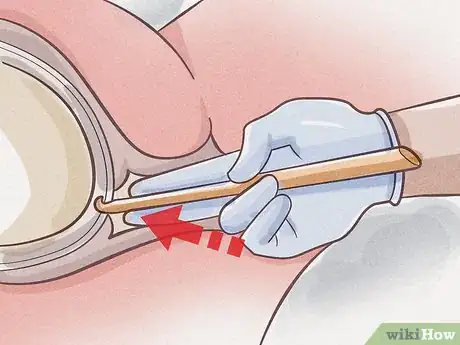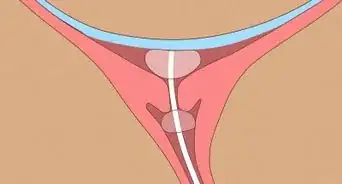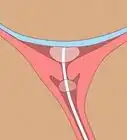This article was co-authored by Carrie Noriega, MD. Dr. Noriega is a Board Certified Obstetrician & Gynecologist and medical writer in Colorado. She specializes in women’s health, rheumatology, pulmonology, infectious disease, and gastroenterology. She received her MD from the Creighton School of Medicine in Omaha, Nebraska and completed her residency at the University of Missouri - Kansas City in 2005.
There are 8 references cited in this article, which can be found at the bottom of the page.
This article has been viewed 1,115,587 times.
By the time you reach the end of your pregnancy, you might be really anxious for it to be over. It makes sense that you're ready to meet your new baby! Your water breaking is a sign that you're either in labor or about to be. If you are full term (or overdue), you might want to encourage labor to begin. There are many natural methods to try, but you should be aware that they are not backed by science. Before trying to encourage your water to break, talk to your doctor. You might also need to have a doctor break your water for you.
Steps
Having a Doctor Break Your Water
-
1Have the doctor break your water if you are in active labor. If your cervix is fully or almost fully dilated, you may be in labor. During a regular exam, your doctor might discover that your are actually in labor. This can happen without your water breaking. In this case, the doctor will likely recommend artificially breaking your water. This is completely normal, and can help get the contractions started. [1]
- You likely won't need to make a separate appointment for this procedure. If the doctor decides that they need to break your water, they will likely do it right away, or meet you at the hospital shortly.
-
2Ask your doctor questions about the procedure. If your doctor recommends artificially breaking your water, you should ask questions to make sure you understand the procedure. Some good questions include:[2]
- Why do I need this procedure?
- Will this help my labor progress?
- Will it be painful?
Advertisement -
3Discuss the benefits and risks. This might sound scary, but your doctor likely won't recommend the procedure if it won't benefit you. It's normal to be apprehensive, so talk to your doctor so that they can help ease any anxiety. They can explain that risks include higher odds of needing a cesarean section or having higher than average bleeding after the birth.[3]
- The benefits typically outweigh the risks. The main benefit is that your labor can progress more quickly, which can be important if you or your baby are dealing with any health issues.
-
4Soothe your nerves with relaxation techniques. The good news is that this procedure is generally no more uncomfortable than a regular vaginal exam. It's also very quick! However, it is completely normal to feel some anxiety. You can try some of these relaxation techniques:[4]
- Deep breathing
- Listening to soothing music
- Meditating
-
5Have your doctor rupture the amniotic membrane artificially. Once your have discussed the procedure with your doctor, they will begin the procedure of rupturing your amniotic membrane (breaking your water). Your doctor will use a sterile, thin, plastic hook to press on the membrane. This cause your water to break and your contractions to become stronger.[5]
Using Natural Methods to Encourage Labor
-
1Perform nipple stimulation. In most cases, labor will begin without any encouragement. If you're looking to safely speed up the process, some people recommend nipple stimulation. The idea is that this will release oxytocin, a hormone that causes contractions. Using your fingers, gently rub or roll your nipples.
- You can also ask your partner to perform nipple stimulation.
- Check with your doctor before you try any methods to encourage labor.
-
2Have sex unless your doctor has said it is unsafe. Sex might also release oxytocin, and an orgasm might stimulate the uterus. Unless your doctor has explicitly advised against it, you can try having sex to encourage later. When labor begins, it might cause your water to break.[6]
- Remember that there is no hard evidence that indicates the effectiveness of sex.
-
3Go for a walk. Another option is to engage in some light physical activity. The theory behind this is that it might also release oxytocin. Try taking a brief, gentle stroll. You don't want to overdo it. You'll need your energy for labor.[7]
- You should talk to your doctor about how frequently you should walk, and for how long.
-
4Eat spicy foods if you can tolerate them. Although there is no scientific evidence to support this, many women report that spicy food helps bring on labor. Be aware, though, that many experts believe that spicy foods release capsaicin, which counteract natural endorphins. This might make labor more painful. If you still want to try something spicy, eat hot peppers or your favorite spicy dish in moderation.[8]
Taking Action When Your Water Breaks
-
1Learn the signs of water breaking. Your water might naturally break at the beginning or during your labor. A lot of people expect a large gush of fluid, but you might have a different experience. In addition to a gush, you could also experience a feeling of wetness in your vagina or frequent leaking of small amounts of liquid from your vagina. [9]
-
2Expect labor to start soon, in most cases. If you're not already in labor, it will likely begin after your water breaks. Get ready to follow your birth plan. If you're going to the hospital, for example, grab your bag and head out the door. Ask for help if you need a ride or other assistance.[10]
-
3Call your doctor or midwife. Wherever you plan to give birth, you should let your healthcare provider know that your water broke. They will likely ask you some questions and give you some instructions.[11]
- If you're not sure if your water has broken or not, you can still give them a call and describe what you are experiencing.
-
4Get induced if labor does not begin. Labor should begin shortly after your water breaks, in most cases. But if it doesn't, your healthcare professional can help you. If labor hasn't begun within 24 hours, you will likely be offered an induction. This might seem scary, but try not to worry. Inducing labor is really common. It can be really helpful because without fluids in the amniotic sac, your baby will be at higher risk for infection. Your doctor might also induce if either you or your baby is suffering from a medical condition such as:[12]
- Hypertension
- Preeclampsia
- Gestational diabetes
- Bleeding during pregnancy[13]
- Your doctor might induce labor by inserting synthetic prostaglandins into your vagina, which can soften the cervix.
- They might also induce by starting an intravenous medication such as Pitocin. This will cause the uterus to contract. [14]
Expert Q&A
-
QuestionIs it possible for labor to progress with out a show?
 Carrie Noriega, MDDr. Noriega is a Board Certified Obstetrician & Gynecologist and medical writer in Colorado. She specializes in women’s health, rheumatology, pulmonology, infectious disease, and gastroenterology. She received her MD from the Creighton School of Medicine in Omaha, Nebraska and completed her residency at the University of Missouri - Kansas City in 2005.
Carrie Noriega, MDDr. Noriega is a Board Certified Obstetrician & Gynecologist and medical writer in Colorado. She specializes in women’s health, rheumatology, pulmonology, infectious disease, and gastroenterology. She received her MD from the Creighton School of Medicine in Omaha, Nebraska and completed her residency at the University of Missouri - Kansas City in 2005.
Board Certified Obstetrician & Gynecologist Yes, labor can progress without having bloody show as long as you are having strong enough contractions to dilate your cervix.
Yes, labor can progress without having bloody show as long as you are having strong enough contractions to dilate your cervix.
References
- ↑ https://www.mayoclinic.org/healthy-lifestyle/labor-and-delivery/in-depth/water-breaking/art-20044142?pg=2
- ↑ http://americanpregnancy.org/labor-and-birth/inducing-labor/
- ↑ https://www.thewomens.org.au/health-information/pregnancy-and-birth/labour-birth/assisted-birth/
- ↑ https://www.fitpregnancy.com/pregnancy/labor-delivery/ask-labor-nurse/breaking-water
- ↑ https://www.mayoclinic.org/healthy-lifestyle/labor-and-delivery/in-depth/water-breaking/art-20044142?pg=2
- ↑ https://health.clevelandclinic.org/truth-or-tale-8-ways-to-maybe-move-labor-along-naturally/
- ↑ https://health.clevelandclinic.org/truth-or-tale-8-ways-to-maybe-move-labor-along-naturally/
- ↑ https://health.clevelandclinic.org/truth-or-tale-8-ways-to-maybe-move-labor-along-naturally/
- ↑ https://www.mayoclinic.org/healthy-lifestyle/labor-and-delivery/in-depth/water-breaking/art-20044142
- ↑ https://www.mayoclinic.org/healthy-lifestyle/labor-and-delivery/in-depth/water-breaking/art-20044142?pg=2
- ↑ https://www.nhs.uk/conditions/pregnancy-and-baby/pages/labour-signs-what-happens.aspx
- ↑ https://www.nhs.uk/conditions/pregnancy-and-baby/pages/labour-signs-what-happens.aspx
- ↑ http://americanpregnancy.org/labor-and-birth/inducing-labor/
- ↑ https://www.nhs.uk/conditions/pregnancy-and-baby/pages/labour-signs-what-happens.aspx
About This Article
If you’re full term or overdue and want to break your water, speak to your doctor about methods like going for a walk or performing nipple stimulation to release oxytocin, a hormone that causes contractions. Your doctor may also ask you to come in for an exam, since you may be in active labor without realizing it. If so, your doctor may recommend artificially breaking your water to get the contractions started. This might sound scary, but the good news is that it’s a quick procedure that’s generally no more uncomfortable than a regular vaginal exam. For more advice from our Gynecology reviewer, including how to get induced if you’re still not in labor after your water breaks, keep reading.









































































Medical Disclaimer
The content of this article is not intended to be a substitute for professional medical advice, examination, diagnosis, or treatment. You should always contact your doctor or other qualified healthcare professional before starting, changing, or stopping any kind of health treatment.
Read More...